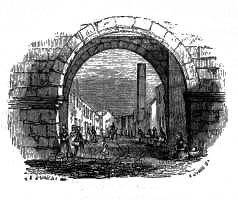The Butler Family in Ireland

Carrickfergus
The Butlers—Quarrels of the Anglo-Norman Nobles—Treachery and its Consequences—The Burkes proclaim themselves Irish—Opposition Parliaments—The Statute of Kilkenny and its Effects—Mistakes of English Writers—Social Life in Ireland described by a French Knight—"Banishment" to Ireland—Richard II. visits Ireland.
[A.D. 1326—1402.]

ICHARD DE BURGO, the Red Earl, died in 1326. He took leave of the nobles after a magnificent banquet at Kilkenny. When he had resigned his possessions to his grandson, William, ha retired into the Monastery of Athassel, where he expired soon after. In the same year Edward II. attempted to take refuge in Ireland, from the vengeance of his people and his false Queen, the "she-wolf of France." He failed in his attempt, and was murdered soon after—A.D. 1327.
The Butler family now appear prominently in Irish history for the first time. It would appear from Carte [7] that the name was originally Walter, Butler being an addition distinctive of office. The family was established in Ireland by Theobald Walter (Gaultier), an Anglo-Norman of high rank, who received extensive grants of land from Henry II., together with the hereditary office of "Pincerna," Boteler, or Butler, in Ireland, to the Kings of England. In this capacity he and his successors were to attend these monarchs at their coronation, and present them with the first cup of wine. In return they obtained many privileges. On account of the quarrels between this family and the De Burgos, De Berminghams, Le Poers, and the southern Geraldines, royal letters were issued, commanding them, under pain of forfeiture, to desist from warring on each other. The result was a meeting of the factious peers in Dublin, at which they engaged to keep the "King's peace." On the following day they were entertained by the Earl of Ulster; the next day, at St. Patrick's, by Maurice FitzThomas; and the third day by the Viceroy and his fellow Knights Hospitallers, who had succeeded the Templars at Kilmainham. The Earldoms of Ormonde [8] and Desmond were now created. The heads of these families long occupied an important place in Irish affairs. Butler died on his return from a pilgrimage to Compostella, and was succeeded by his eldest son, Jacques—"a liberal, friendly, pleasant, and stately youth"—who was married this year to King Edward's cousin, Eleanor, daughter of the Earl of Essex. The Desmond peerage was created in 1329, when the County Palatine [9] of Kerry was given to that family.
Notes
[7] Carte.—See his Life of the Duke of Ormonde, folio edition, p. 7.
[8] Ormonde.—The name Ormonde is intended to represent the Irish appellative Ur-Mhumhain, or Eastern Munster. This part of the country was the inheritance of Cairbré Musc.
[9] Palatine.—The Lords-Palatine were endowed with extraordinary power, and were able to exorcise a most oppressive tyranny over the people under their government.
